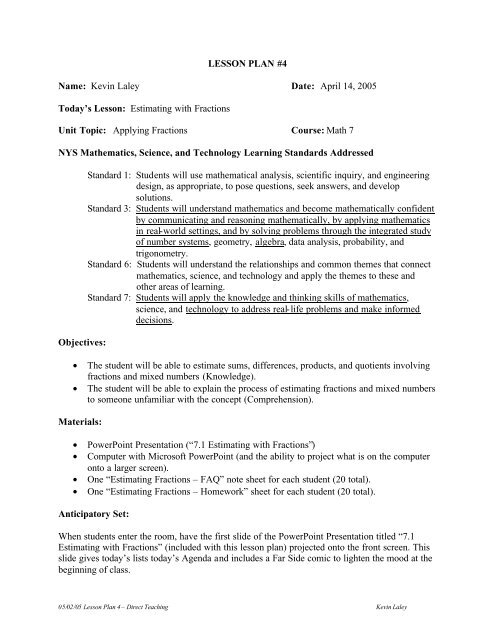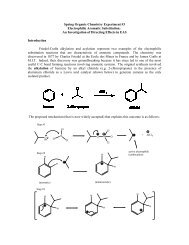Lesson Plan 4 - Direct Teaching
Lesson Plan 4 - Direct Teaching
Lesson Plan 4 - Direct Teaching
You also want an ePaper? Increase the reach of your titles
YUMPU automatically turns print PDFs into web optimized ePapers that Google loves.
Once everyone is seated, click to the next slide (“Warm-Up”). This slide instructs the students towrite a short paragraph in their math journals explaining how they would explain to someone theprocess of estimating the numbers 59.6541, 4.302, and 77.77777 to the nearest tenth. Givestudents between 3-5 minutes to complete this task, and then ask, “Can someone volunteer toread what he or she has written for the class?” (Responses should explain that 59.6541 would berounded to 59.7, because the digit in the hundredths place is a 5, and the rule for roundingnumbers is to round up if this digit is 5 or higher and round down otherwise. Using thisreasoning, 4.302 would be rounded to 4.3 and 77.77777 would be rounded to 77.8.)Say, “Today, we are going to devise a rule somewhat similar to this for estimating fractions andmixed numbers.”<strong>Lesson</strong> Body:Hand out one “Estimating Fractions – FAQ” note sheet to each student. Ask everyone to fill inthis sheet as we cover today’s lesson. (All answers appear in the PowerPoint presentation.) Clickthe PowerPoint presentation to the next slide (slide 3). The first question from the note sheetshould appear on the screen, “Why would we want to know how to estimate fractions?” Givestudents a change to suggest an answer of their own, and then click the mouse button to revealthe response “to quickly estimate the sum, difference, product, or quotient of an expressioninvolving fractions or mixed numbers.” (Throughout this lesson, students should be writing thewords written in italics on their note sheet.)Next, pose the question “When am I ever going to need to estimate fractions?” Click the mousebutton three times to reveal the first three responses (Approximating the amount of ingredientsneeded in a recipe, Estimating the amount of money you will make doing a job, Estimating thedistance between two locations). Clicking the mouse button one more time will reveal “Anyother ideas?” in which the floor should be open to the students for any additional examples theymay have.Move on to the next slide by clicking the mouse button. This slide (4) corresponds with the nextbullet on the note sheet: “To estimate the sum or difference of fractions, round each fractionto…” Clicking the mouse button twice will reveal the answer: 0, ½, or 1, whichever is closest.After students have had a chance to write this down, click on to slide 5 to answer the nextquestion, “How do you decide what to round to?” Clicking the button again reveals “Drawingfraction models can help you decide how to round.” Example A illustrates this technique. Clickthe mouse button again to reveal the example of rounding 5/8 that is already printed on thestudents’ note sheets. Show that the white bar is divided into 8 even pieces, and that five of thesepieces have been filled in blue to represent 5/8. Notice that 0, ½, and 1 are also clearly markedon this bar, and ask students, “Is the end of the blue bar closest to 0, ½, or 1?. (Students shouldsee that 5/8 is closet to ½, and should write this answer in the appropriate line on their notesheet.) Clicking the mouse button again also reveals this answer.Click to the next slide (6), and then click the mouse button two more times to reveal thecautionary note: “It is deceiving what to round some fractions to, so if you ever have any doubt,draw the fraction models to help you.” Clicking the mouse button three more times reveals05/02/05 <strong>Lesson</strong> <strong>Plan</strong> 4 – <strong>Direct</strong> <strong>Teaching</strong> Kevin Laley
Example B: “What would you round 1/3 to?” As before, a fraction model has been drawn on thePowerPoint screen, (but it has been left for the students to draw in their notes). Show studentsthat in this case, although their first instinct may be to round this fraction to 0, the blue bar isactually closer to ½ than 0. Click the mouse button again to show the answer: 1/3 should berounded to ½.Click to the next slide (7) for Example C. Explain that this question, What would you round 2/3to, is also deceiving. Click the mouse two times to reveal the question. Say, “Your instinct maybe to round 2/3 to 1, but if we take a look at the fraction model, we find that this is not the bestanswer.” (Click the mouse again to reveal the fraction model). Show students that this time, theblue bar is actually closer to ½ than 1. Click the mouse one more time to reveal the answer: ½.Move on to slide 8 – “Activity.” Allow students to work with the person they’re sitting next toand estimate each of the fractions listed on the screen (which are also printed on their sheet) to 0,½, or 1 and place them in the appropriate column in the table on their note sheet. Give studentsbetween 5 and 10 minutes to complete this, and then go around the class asking the pairs whatthey estimated each fraction to, beginning with 1/5 and proceeding through 5/6. (Each time, aftera pair gives their answer, click the mouse button once and the fraction will slide down to itscorrect column in the table on the screen.)Click on to slide 9 – which gives students one more essential note before bringing the lesson to aclose: “What about Mixed Numbers?” Explain “when we are asked to estimate mixed numbers,we use a similar process. The mixed number can either be rounded down the whole number thatappears in the mixed number, the “½ of the mixed number” or one greater than the wholenumber that appears in the mixed number.” Example D illustrates this: 7 ¼ can either be roundedto (a) 7 , (b) 7 ½ , or (c) 8. Ask students “Can anyone tell me why estimating this mixed numberis especially difficult?” (Students should say that 7 ¼ falls directly between 7 and 7 ½.) Say,“Numbers like this are somewhat ambiguous to round. In this case, it is acceptable to eitherround down to 7 or round up to 7 ½.”Closure:The next slide, (10) contains the essential question for this lesson, which students are again askedto respond to in a brief paragraph written in their journal. (Allow about 5 minutes for this).(1) Summarize what you learned about estimating fractions and mixed numbers today.(Responses should include that fractions can be estimating by either rounding them to 0, ½, or 1,and a similar procedure is used when rounding mixed numbers. Mention should also be made ofusing fraction models to help decide which of these the number should be rounded to. Otherresponses are possible as well.)If time permits, ask a student or two to volunteer what they have written. Lastly, click to the lastslide (11) which lists the homework assignment. Pass out the sheet labeled “Homework: 7.1Estimating with Fractions” to each student.05/02/05 <strong>Lesson</strong> <strong>Plan</strong> 4 – <strong>Direct</strong> <strong>Teaching</strong> Kevin Laley
Accommodations for IEP:Since this lesson is essentially uses a direct teaching method of instruction, the student withADD may have a particularly difficult time focusing. Remind the student before class that he isexpected to complete all notes and activities that are contained within today’s lesson, but if hefeels like he needs to get up and stretch once or twice during the period, he may do so quietly.Homework/AssessmentThe homework worksheet (7.1 Estimating with Fractions) essentially reviews the conceptspresented in the PowerPoint presentation, as well as taking the lesson a step further. Students arefirst asked to round fractions to 0, ½, or 1 (as they did in the class activity) as well as estimatingthe mixed numbers, as shown in the lesson. After this, they are asked to use this knowledge toestimate some algebraic expressions by first estimating the fractions and mixed numberscontained within them. Finally, students are presented with a real-life scenario in the form of aword problem that uses the techniques from today’s lesson.ExtensionsIf time permits, have students do exercises 16-43 on page 270 of their textbook orally. Theseproblems ask them to round fractions or estimate expressions involving fractions. By havingthem practice doing these orally, they will gain practice for the homework and also see therelevance of estimating with fractions. (It allows them to evaluate otherwise difficult expressionsquickly.)05/02/05 <strong>Lesson</strong> <strong>Plan</strong> 4 – <strong>Direct</strong> <strong>Teaching</strong> Kevin Laley
Name:Notes: 7.1 Estimating with FractionsDate:Estimating Fractions - FAQ• Why would we want to know how to estimate fractions?______________________________________________________________________________________________________________________________________________________________________________________________________________________________• When am I ever going to need to estimate fractions?1) _____________________________________________________________________2) _____________________________________________________________________3) _____________________________________________________________________4) _____________________________________________________________________• To estimate the sum or difference of fractions, round each fraction to____, ____, or ____.• How do you decide what to round to?____________________________________________________________________________________________________________________________________________________Example A:58 =10 12Is 5/8 closest to 0, 1/2, or 1? ________05/02/05 <strong>Lesson</strong> <strong>Plan</strong> 4 – <strong>Direct</strong> <strong>Teaching</strong> Kevin Laley
Caution!!!• It is deceiving what to round some fractions to, so if you ever have any doubt …__________________________________________________________________________Example B:What would you round 1/3 to? ________Example C:What would you round 2/3 to? ________Activity:Estimate each of the fractions below to whichever is closest and place them in the appropriatecolumn in the table that follows.1513921712829671121232371156Fractions Close to 0 Fractions Close to 1/2 Fractions Close to 1What About Mixed Numbers?• We can follow a similar procedure for estimating mixed numbers.Example D:What would you round174to?(a) 7 (b) 7 ½ (c) 805/02/05 <strong>Lesson</strong> <strong>Plan</strong> 4 – <strong>Direct</strong> <strong>Teaching</strong> Kevin Laley
Name:Homework: 7.1 Estimating with FractionsDate:‣ Round each fraction to 0, 1/2, or 1:(1) 1 ______ (2) 3 ______ (3) 9 ______ (4) 3 ______65101021710(5) ______ (6) ______ (7) ______ (8) ______745013‣ Estimate each mixed number:(9)1______ (10)3_______ (11)94 _______ (12)47 14 1 ______6 13 13 9‣ Estimate each expression by first estimating the fractions and then adding theestimations.Example: 1 + 7 à 1 12 8 2 + à 112(13) 3 − 2(14)8 95 25 × 87 3(15)1 321 ÷ 1(16) 1 + 2 −72 43 3 8‣ Answer the following question:Komodo dragons are the largest lizards ever to have lived. A 250-point komodo dragon can eatenough in one sitting to increase its weight by 3/4. Estimate 3/4 x 250 to find how much weight akomodo dragon would gain after eating.05/02/05 <strong>Lesson</strong> <strong>Plan</strong> 4 – <strong>Direct</strong> <strong>Teaching</strong> Kevin Laley
















